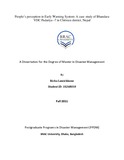| dc.contributor.advisor | Rahman, Md. Rezaur | |
| dc.contributor.author | Lamichhane, Richa | |
| dc.date.accessioned | 2012-05-24T05:59:33Z | |
| dc.date.available | 2012-05-24T05:59:33Z | |
| dc.date.copyright | 2011 | |
| dc.date.issued | 2011 | |
| dc.identifier.other | ID 10268010 | |
| dc.identifier.uri | http://hdl.handle.net/10361/1821 | |
| dc.description | This dissertation is submitted in partial fulfillment of the requirements for the degree of Master in Disaster Management, 2011. | |
| dc.description | Cataloged from PDF version of Dissertation. | |
| dc.description | Includes bibliographical references (page 51- 52). | |
| dc.description.abstract | Flood impact and vulnerability towards the poor people has always been significant aspect of issue and discussion worldwide. With the current climate change scenario and various studies in the past related to climate change has shown that flood frequency has increased leaving people in the flood plains more vulnerable. People in the river bank due to lack of EWS and also due to the inefficiency of the prevailing system they are more prone to stresses and burden in their lives due to floods. The main objective of the paper was to understand the perception of the particular community towards the prevailing Early Warning System (EWS) their response mechanism during the flood at Padariya-7 of Bhandara VDC in Chitwan district of Nepal.. For this research participatory tools for assessing the perception and response mechanism, various tools like, Resource Mapping, Timeline Analysis, Focus Group Discussion were used and Key Informant Interview(KII) was used for the validating the findings. To assess the information literature were reviewed from different journal article, published books, government policies, and other unpublished thesis work and articles. EWS is a very important aspect of Disaster Risk Reduction (DRR). For the people in the community since the establishment of the system it has proved not of any significance. People were hostile towards the project as it was giving false sense of hope towards the people. No proper warning dissemination techniques were found during the study. Moreover villagers have no regular drills even though the project was in the implementation phase. Rather than using the Early Warning facility people living in the river bank for many decades they were more found to be using the traditional knowledge for forecasting of the flood. No focus of the NGO was found to be upgrading the EWS after it was over. Though most of the people go to the embankment to see the level of the river during the rainy season the problem is more acute for the disabled, old age, ill people and lactating mother which has less mobility. As the nature of the flood is flash in the area there is less time for people to respond and they only manage to save their lives and livestock from the past experiences.
Thus the study suggest to address the challenges in the early warning facility for the community with the help of study at micro level and making plans policies and programme of improvement of the system with more lead time of forecast and proper dissemination techniques for the sufferer of the flood in the river basin of Rapti. | en_US |
| dc.description.statementofresponsibility | Richa Lamichhane | |
| dc.format.extent | 52 pages | |
| dc.language | en | |
| dc.publisher | BRAC University | en_US |
| dc.rights | BRAC University dissertation are protected by copyright. They may be viewed from this source for any purpose, but reproduction or distribution in any format is prohibited without written permission. | |
| dc.subject | Disaster management | |
| dc.subject | Climate change | |
| dc.subject | Early warning | |
| dc.title | People's perception in Early Warning System: a case study of Bhandara VDC Padariya-7 in Chitwan district, Nepal | en_US |
| dc.type | Dissertation | en_US |
| dc.contributor.department | Department of Architecture, BRAC University | |
| dc.description.degree | M. Disaster Management | |

